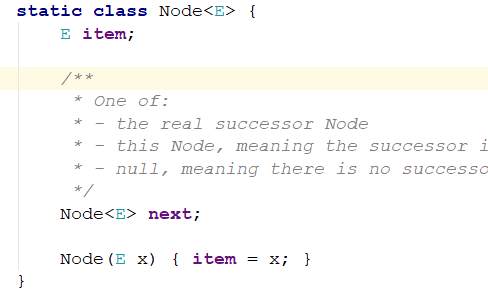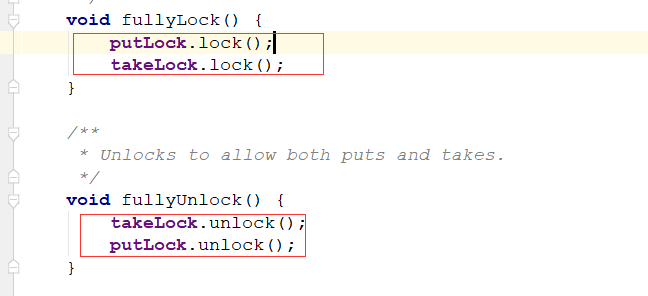第七章 LinkedBlockingQueue源码解析
1、对于LinkedBlockingQueue需要掌握以下几点
- 创建
- 入队(添加元素)
- 出队(删除元素)
2、创建
Node节点内部类与LinkedBlockingQueue的一些属性
static class Node<E> {
E item;//节点封装的数据
/**
* One of:
* - the real successor Node
* - this Node, meaning the successor is head.next
* - null, meaning there is no successor (this is the last node)
*/
Node<E> next;//下一个节点
Node(E x) { item = x; }
}
/** 指定链表容量 */
private final int capacity;
/** 当前的元素个数 */
private final AtomicInteger count = new AtomicInteger(0);
/** 链表头节点 */
private transient Node<E> head;
/** 链表尾节点 */
private transient Node<E> last;
/** 出队锁 */
private final ReentrantLock takeLock = new ReentrantLock();
/** 出队等待条件 */
private final Condition notEmpty = takeLock.newCondition();
/** 入队锁 */
private final ReentrantLock putLock = new ReentrantLock();
/** 入队等待条件 */
private final Condition notFull = putLock.newCondition();
2.1、public LinkedBlockingQueue(int capacity)
使用方法:
Queue<String> abq = new LinkedBlockingQueue<String>(1000);
源代码:
/**
* 创建一个 LinkedBlockingQueue,容量为指定容量
*/
public LinkedBlockingQueue(int capacity) {
if (capacity <= 0) throw new IllegalArgumentException();
this.capacity = capacity;
last = head = new Node<E>(null);//初始化头节点和尾节点,均为封装了null数据的节点
}
注意点:
- LinkedBlockingQueue的组成一个链表+两把锁+两个条件
2.2、public LinkedBlockingQueue()
使用方法:
Queue<String> abq = new LinkedBlockingQueue<String>();
源代码:
/**
* 创建一个LinkedBlockingQueue,容量为整数最大值
*/
public LinkedBlockingQueue() {
this(Integer.MAX_VALUE);
}
注意点:默认容量为整数最大值,可以看做没有容量限制
3、入队:
3.1、public boolean offer(E e)
原理:
- 在队尾插入一个元素, 如果队列没满,立即返回true; 如果队列满了,立即返回false
使用方法:
- abq.offer("hello1");
源代码:
/**
* 在队尾插入一个元素, 容量没满,可以立即插入,返回true; 队列满了,直接返回false
* 注:如果使用了限制了容量的队列,这个方法比add()好,因为add()插入失败就会抛出异常
*/
public boolean offer(E e) {
if (e == null)
throw new NullPointerException();
final AtomicInteger count = this.count;// 获取队列中的元素个数
if (count.get() == capacity)// 队列满了
return false;
int c = -1;
final ReentrantLock putLock = this.putLock;
putLock.lock();// 获取入队锁
try {
if (count.get() < capacity) {// 容量没满
enqueue(e);// 入队
c = count.getAndIncrement();// 容量+1,返回旧值(注意)
if (c + 1 < capacity)// 如果添加元素后的容量,还小于指定容量(说明在插入当前元素后,至少还可以再插一个元素)
notFull.signal();// 唤醒等待notFull条件的其中一个线程
}
} finally {
putLock.unlock();// 释放入队锁
}
if (c == 0)// 如果c==0,这是什么情况?一开始如果是个空队列,就会是这样的值,要注意的是,上边的c返回的是旧值
signalNotEmpty();
return c >= 0;
}
/**
* 创建一个节点,并加入链表尾部
* @param x
*/
private void enqueue(E x) {
/*
* 封装新节点,并赋给当前的最后一个节点的下一个节点,然后在将这个节点设为最后一个节点
*/
last = last.next = new Node<E>(x);
}
private void signalNotEmpty() {
final ReentrantLock takeLock = this.takeLock;
takeLock.lock();//获取出队锁
try {
notEmpty.signal();//唤醒等待notEmpty条件的线程中的一个
} finally {
takeLock.unlock();//释放出队锁
}
}
如果,入队逻辑不懂,查看最后总结部分入队逻辑的图,代码非常简单,流程看注释即可。
3.2、public boolean offer(E e, long timeout, TimeUnit unit) throws InterruptedException
原理:
- 在队尾插入一个元素,,如果队列已满,则进入等待,直到出现以下三种情况:
- 被唤醒
- 等待时间超时
- 当前线程被中断
使用方法:
try {
abq.offer("hello2",1000,TimeUnit.MILLISECONDS);
} catch (InterruptedException e) {
e.printStackTrace();
}
源代码:
/**
* 在队尾插入一个元素,,如果队列已满,则进入等待,直到出现以下三种情况:
* 1、被唤醒
* 2、等待时间超时
* 3、当前线程被中断
*/
public boolean offer(E e, long timeout, TimeUnit unit)
throws InterruptedException {
if (e == null)
throw new NullPointerException();
long nanos = unit.toNanos(timeout);// 转换为纳秒
int c = -1;
final ReentrantLock putLock = this.putLock;// 入队锁
final AtomicInteger count = this.count;// 总数量
putLock.lockInterruptibly();
try {
while (count.get() == capacity) {// 容量已满
if (nanos <= 0)// 已经超时
return false;
/*
* 进行等待: 在这个过程中可能发生三件事:
* 1、被唤醒-->继续当前这个while循环
* 2、超时-->继续当前这个while循环
* 3、被中断-->抛出中断异常InterruptedException
*/
nanos = notFull.awaitNanos(nanos);
}
enqueue(e);// 入队
c = count.getAndIncrement();// 入队元素数量+1
if (c + 1 < capacity)
notFull.signal();
} finally {
putLock.unlock();
}
if (c == 0)
signalNotEmpty();
return true;
}
注意:
- awaitNanos(nanos)是AQS中的一个方法,这里就不详细说了,有兴趣的自己去查看AQS的源代码。
3.3、public void put(E e) throws InterruptedException
原理:
- 在队尾插入一个元素,如果队列满了,一直阻塞,直到队列不满了或者线程被中断
使用方法:
try {
abq.put("hello1");
} catch (InterruptedException e) {
e.printStackTrace();
}
源代码:
/**
* 在队尾插一个元素
* 如果队列满了,一直阻塞,直到队列不满了或者线程被中断
*/
public void put(E e) throws InterruptedException {
if (e == null) throw new NullPointerException();
int c = -1;
final ReentrantLock putLock = this.putLock;//入队锁
final AtomicInteger count = this.count;//当前队列中的元素个数
putLock.lockInterruptibly();//加锁
try {
while (count.get() == capacity) {//如果队列满了
/*
* 加入notFull等待队列,直到队列元素不满了,
* 被其他线程使用notFull.signal()唤醒
*/
notFull.await();
}
enqueue(e);//入队
c = count.getAndIncrement();//入队数量+1
if (c + 1 < capacity)
notFull.signal();
} finally {
putLock.unlock();
}
if (c == 0)
signalNotEmpty();
}
4、出队
4.1、public E poll()
原理:
- 如果没有元素,直接返回null;如果有元素,出队
使用方法:
abq.poll();
源代码:
/**
* 出队:
* 1、如果没有元素,直接返回null
* 2、如果有元素,出队
*/
public E poll() {
final AtomicInteger count = this.count;// 获取元素数量
if (count.get() == 0)// 没有元素
return null;
E x = null;
int c = -1;
final ReentrantLock takeLock = this.takeLock;
takeLock.lock();// 获取出队锁
try {
if (count.get() > 0) {// 有元素
x = dequeue();// 出队
// 元素个数-1(注意:该方法是一个无限循环,直到减1成功为止,且返回旧值)
c = count.getAndDecrement();
if (c > 1)// 还有元素(如果旧值c==1的话,那么通过上边的操作之后,队列就空了)
notEmpty.signal();// 唤醒等待在notEmpty队列中的其中一条线程
}
} finally {
takeLock.unlock();// 释放出队锁
}
if (c == capacity)// c == capacity是怎么发生的?如果队列是一个满队列,注意:上边的c返回的是旧值
signalNotFull();
return x;
}
/**
* 从队列头部移除一个节点
*/
private E dequeue() {
Node<E> h = head;//获取头节点:x==null
Node<E> first = h.next;//将头节点的下一个节点赋值给first
h.next = h; // 将当前将要出队的节点置null(为了使其做head节点做准备)
head = first;//将当前将要出队的节点作为了头节点
E x = first.item;//获取出队节点的值
first.item = null;//将出队节点的值置空
return x;
}
private void signalNotFull() {
final ReentrantLock putLock = this.putLock;
putLock.lock();
try {
notFull.signal();
} finally {
putLock.unlock();
}
}
注意:出队逻辑如果不懂,查看最后总结部分的图
4.2、public E poll(long timeout, TimeUnit unit) throws InterruptedException
原理:
- 从队头删除一个元素,如果队列不空,出队;如果队列已空且已经超时,返回null;如果队列已空且时间未超时,则进入等待,直到出现以下三种情况:
- 被唤醒
- 等待时间超时
- 当前线程被中断
使用方法:
try {
abq.poll(1000, TimeUnit.MILLISECONDS);
} catch (InterruptedException e) {
e.printStackTrace();
}
源代码:
/**
* 从队列头部删除一个元素,
* 如果队列不空,出队;
* 如果队列已空,判断时间是否超时,如果已经超时,返回null
* 如果队列已空且时间未超时,则进入等待,直到出现以下三种情况:
* 1、被唤醒
* 2、等待时间超时
* 3、当前线程被中断
*/
public E poll(long timeout, TimeUnit unit) throws InterruptedException {
E x = null;
int c = -1;
long nanos = unit.toNanos(timeout);
final AtomicInteger count = this.count;
final ReentrantLock takeLock = this.takeLock;
takeLock.lockInterruptibly();
try {
while (count.get() == 0) {//如果队列没有元素
if (nanos <= 0)//已经超时
return null;
/*
* 进行等待:
* 在这个过程中可能发生三件事:
* 1、被唤醒-->继续当前这个while循环
* 2、超时-->继续当前这个while循环
* 3、被中断-->抛出异常
*/
nanos = notEmpty.awaitNanos(nanos);
}
x = dequeue();//出队
c = count.getAndDecrement();
if (c > 1)
notEmpty.signal();
} finally {
takeLock.unlock();
}
if (c == capacity)
signalNotFull();
return x;
}
4.3、public E take() throws InterruptedException
原理:
- 将队头元素出队,如果队列空了,一直阻塞,直到队列不为空或者线程被中断
使用方法:
try {
abq.take();
} catch (InterruptedException e) {
e.printStackTrace();
}
源代码:
/**
* 出队:
* 如果队列空了,一直阻塞,直到队列不为空或者线程被中断
*/
public E take() throws InterruptedException {
E x;
int c = -1;
final AtomicInteger count = this.count;//获取队列中的元素总量
final ReentrantLock takeLock = this.takeLock;
takeLock.lockInterruptibly();//获取出队锁
try {
while (count.get() == 0) {//如果没有元素,一直阻塞
/*
* 加入等待队列, 一直等待条件notEmpty(即被其他线程唤醒)
* (唤醒其实就是,有线程将一个元素入队了,然后调用notEmpty.signal()唤醒其他等待这个条件的线程,同时队列也不空了)
*/
notEmpty.await();
}
x = dequeue();//出队
c = count.getAndDecrement();//元素数量-1
if (c > 1)
notEmpty.signal();
} finally {
takeLock.unlock();
}
if (c == capacity)
signalNotFull();
return x;
}
总结:
1、具体入队与出队的原理图:
图中每一个节点前半部分表示封装的数据x,后边的表示指向的下一个引用。
1.1、初始化

初始化之后,初始化一个数据为null,且head和last节点都是这个节点。
1.2、入队两个元素过后

这个可以根据入队方法enqueue(E x)来看,源代码再贴一遍:
/**
* 创建一个节点,并加入链表尾部
*
* @param x
*/
private void enqueue(E x) {
/*
* 封装新节点,并赋给当前的最后一个节点的下一个节点,然后在将这个节点设为最后一个节点
*/
last = last.next = new Node<E>(x);
}
其实这我们就可以发现其实真正意义上出队的头节点是Head节点的下一个节点。(这也就是Node这个内部类中对next的注释,我没有翻译)
1.3、出队一个元素后

表面上看,只是将头节点的next指针指向了要删除的x1.next,事实上这样我觉的就完全可以,但是jdk实际上是将原来的head节点删除了,而上边看到的这个head节点,正是刚刚出队的x1节点,只是其值被置空了。
这一块对应着源代码来看:dequeue()
/**
* 从队列头部移除一个节点
*/
private E dequeue() {
Node<E> h = head;// 获取头节点:x==null
Node<E> first = h.next;// 将头节点的下一个节点赋值给first
h.next = h; // 将当前将要出队的节点置null(为了使其做head节点做准备)
head = first;// 将当前将要出队的节点作为了头节点
E x = first.item;// 获取出队节点的值
first.item = null;// 将出队节点的值置空
return x;
}
2、三种入队对比:
- offer(E e):如果队列没满,立即返回true; 如果队列满了,立即返回false-->不阻塞
- put(E e):如果队列满了,一直阻塞,直到队列不满了或者线程被中断-->阻塞
- offer(E e, long timeout, TimeUnit unit):在队尾插入一个元素,,如果队列已满,则进入等待,直到出现以下三种情况:-->阻塞
- 被唤醒
- 等待时间超时
- 当前线程被中断
3、三种出队对比:
- poll():如果没有元素,直接返回null;如果有元素,出队
- take():如果队列空了,一直阻塞,直到队列不为空或者线程被中断-->阻塞
- poll(long timeout, TimeUnit unit):如果队列不空,出队;如果队列已空且已经超时,返回null;如果队列已空且时间未超时,则进入等待,直到出现以下三种情况:
- 被唤醒
- 等待时间超时
- 当前线程被中断
4、ArrayBlockingQueue与LinkedBlockingQueue对比
- ArrayBlockingQueue:
- 一个对象数组+一把锁+两个条件
- 入队与出队都用同一把锁
- 在只有入队高并发或出队高并发的情况下,因为操作数组,且不需要扩容,性能很高
- 采用了数组,必须指定大小,即容量有限
- LinkedBlockingQueue:
- 一个单向链表+两把锁+两个条件
- 两把锁,一把用于入队,一把用于出队,有效的避免了入队与出队时使用一把锁带来的竞争。
- 在入队与出队都高并发的情况下,性能比ArrayBlockingQueue高很多
- 采用了链表,最大容量为整数最大值,可看做容量无限
两个疑问:
- 入队时:c==0是怎样出现的?
- 出队时:c==capcity是怎样出现的?
一:概念
LinkedBlockingQueue是一个用链表实现的有界阻塞队列。此队列的默认和最大长度为 Integer.MAX_VALUE。此队列按照先进先出的原则对元素进行排序。
与ArrayBlockingQueue的异同:
ArrayBlockingQueue: 必须设置长度容量 底层数组结构 单锁控制
LinkedBlockingQueue:默认Integer最大值 底层链表结构 双锁
二:LinkedBlockingQueue源码实现
不设置容量,默认为Integer的最大值

也支持设置容量

也支持预先将集合设置入队列

两把锁,一个take锁,控制消费者并发,一个put锁,控制生产者并发:


内部维护单向链表结构:

来看一下主要方法:offer与poll
offer方法:
如果e为null或者对列已满,返回false, 然后加锁,其他的生产者会被阻塞,再次判断如果对列里面元素数量小于容量,那么入队,对列的数量也自加,
如果这时对列仍然有空间,会唤醒正在等待的其他生产者,向对列里面放数据。
|
1
2
3
4
5
6
7
8
9
10
11
12
13
14
15
16
17
18
19
20
21
22
23
|
public boolean offer(E e) { if (e == null) throw new NullPointerException(); final AtomicInteger count = this.count; if (count.get() == capacity) return false; int c = -1; Node<E> node = new Node<E>(e); final ReentrantLock putLock = this.putLock; putLock.lock(); try { if (count.get() < capacity) { enqueue(node); c = count.getAndIncrement(); if (c + 1 < capacity) notFull.signal(); } } finally { putLock.unlock(); } if (c == 0) signalNotEmpty(); return c >= 0; } |
入队方法:

如果是第一次放入数据,效果图:

主要是建立两个连接,让最后一个元素last指向新来的元素,然后将last指针指向新来的。
再来看一下poll方法:取数据
如果对列为空,返回null ,然后加锁,其他想取数据的消费者线程会被阻塞, 如果没有数据释放锁,返回null,对列有数据,则出队,对列自减,
如果出队后对列中还有数据,那么会唤醒正在等待的其他消费者线程来取数据。
|
1
2
3
4
5
6
7
8
9
10
11
12
13
14
15
16
17
18
19
20
21
22
|
public E poll() { final AtomicInteger count = this.count; if (count.get() == 0) return null; E x = null; int c = -1; final ReentrantLock takeLock = this.takeLock; takeLock.lock(); try { if (count.get() > 0) { x = dequeue(); c = count.getAndDecrement(); if (c > 1) notEmpty.signal(); } } finally { takeLock.unlock(); } if (c == capacity) signalNotFull(); return x; } |
出队方法:

返回first的item元素,这个链表的头结点维护的都是空节点,效果图如下:
出队前:

出队后:

add 和remove:
add方法: 直接使用父类AbstractQueue的方法:
在offer的基础上进行了保证,成功返回true,false的时候返回异常。

remove方法:

两把锁同时上锁,两把锁同时解锁:

来看一下删除元素的动作:因为数据结构是链表,所以只需要把指向该节点的上一个节点的next变量不指向该节点即可,然后
gc的时候就会把该节点回收掉:
trial.next = p.next 的作用就是让p节点的前一个元素直接指向p的后一个元素,而数组结构就是把该下标置为null object[takeIndex] == null

put和take方法:
put方法:
|
1
2
3
4
5
6
7
8
9
10
11
12
13
14
15
16
17
18
19
20
21
22
23
24
25
26
27
28
29
30
31
|
public void put(E e) throws InterruptedException { if (e == null) throw new NullPointerException(); // Note: convention in all put/take/etc is to preset local var // holding count negative to indicate failure unless set. int c = -1; Node<E> node = new Node<E>(e); final ReentrantLock putLock = this.putLock; final AtomicInteger count = this.count; putLock.lockInterruptibly(); try { /* * Note that count is used in wait guard even though it is * not protected by lock. This works because count can * only decrease at this point (all other puts are shut * out by lock), and we (or some other waiting put) are * signalled if it ever changes from capacity. Similarly * for all other uses of count in other wait guards. */ while (count.get() == capacity) { notFull.await(); } enqueue(node); c = count.getAndIncrement(); if (c + 1 < capacity) notFull.signal(); } finally { putLock.unlock(); } if (c == 0) signalNotEmpty(); } |
take方法:
take方法的判断逻辑与poll基本相同,唯一区别是,如果对列没有元素,take为阻塞消费者线程,而poll会返回false。
|
1
2
3
4
5
6
7
8
9
10
11
12
13
14
15
16
17
18
19
20
21
|
public E take() throws InterruptedException { E x; int c = -1; final AtomicInteger count = this.count; final ReentrantLock takeLock = this.takeLock; takeLock.lockInterruptibly(); try { while (count.get() == 0) { notEmpty.await(); } x = dequeue(); c = count.getAndDecrement(); if (c > 1) notEmpty.signal(); } finally { takeLock.unlock(); } if (c == capacity) signalNotFull(); return x; } |




 浙公网安备 33010602011771号
浙公网安备 33010602011771号